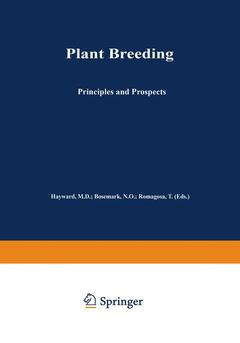Plant Breeding, Softcover reprint of the original 1st ed. 1993 Principles and prospects Plant Breeding Series
Langue : Anglais

Our requirement for plant breeders to be successful has never been greater. However one views the forecasted numbers for future population growth we will need, in the immediate future, to be feeding, clothing and housing many more people than we do, inadequately, at present. Plant breeding represents the most valuable strategy in increasing our productivity in a way that is sustainable and environmentally sensitive. Plant breeding can rightly be considered as one of the oldest multidisciplinary subjects that is known to humans. It was practised by people who first started to carry out a settled form of agriculture. The art, as it must have been at that stage, was applied without any formal underlying framework, but achieved dramatic results, as witnessed by the forms of cultivated plants we have today. We are now learning how to apply successfully the results of yet imperfect scientific knowledge. This knowledge is, however, rapidly developing, particularly in areas of tissue culture,biotechnology and molecular biology. Plant breeding's inherent multifaceted nature means that alongside obvious subject areas like genetics we also need to consider areas such as: statistics, physiology, plant pathology, entomology, biochemistry, weed science, quality, seed characteristics, repro ductive biology, trial design, selection and computing. It therefore seems apparent that modern plant breeders need to have a grasp of wide range of scientific knowledge and expertise if they are successfully to a exploit the techniques, protocols and strategies which are open to them.
One Introduction.- Two Genetic Systems and Population Structure.- 1 Genetic systems, recombination and variability.- 2 Population structure and variability.- Three Sources of Variation.- 3 Plant genetic resources.- 4 Induced mutations.- 5 Interspecific hybridization by sexual means.- 6 Chromosome manipulation and polyploidy.- 7 Somatic hybridization.- 8 Gene cloning and identification.- 9 Gene transfer to plants: approaches and available techniques.- 10 The role of gene technology in plant breeding.- Four Assessment of Variation.- 11 Biometrical genetics in breeding.- 12 Biochemical characterization of populations.- Five Manipulation of Genetic Systems.- 13 Self- and cross-incompatibility systems.- 14 Male sterility.- 15 Apomixis.- 16 Micropropagation and somatic embryogenesis.- 17 Andro- and parthenogenesis.- Six Selection Methods.- 18 Selection strategies and choice of breeding methods.- 19 Marker-assisted selection.- 20 Gametophytic and sporophytic selection.- 21 In vitro selection.- Seven Adaptation.- 22 Genotype × environment interaction and adaptation.- 23 Augmenting yield-based selection.- 24 Resistance to abiotic stresses.- 25 Resistance to parasites.- Eight Specific Trait Breeding.- 26 Breeding for improved symbiotic nitrogen fixation.- 27 Photosynthetic and respiratory efficiency.- 28 Breeding for efficient root systems.- 29 On the utilization of renewable plant resources.- Nine Epilogue.- 30 The need for a comprehensive plant breeding strategy.- Species Index.
The text is supported by many tables diagrams and excellent illustrations together with lists of references. There are good species and subject indexes. - Agricultural Progress., The main merit of this book ... is to provide up-to-date comprehensive information in an accessible and integrated form for both postgraduate courses and research. This book is an excellent compilation of recent advances in crop improvement, written by 46 experts from 12 countries. ... The chapters are well written and logically organised. I recommend this book to both breeders and biologists working in various areas of plant improvement and wishing to be kept informed in depth about new techniques. - Planzen, ...a well balanced introduction from world authorities on the principles and practice of plant breeding...it should be required reading for all students... - Experimental Agriculture
Date de parution : 10-2012
Ouvrage de 550 p.
17.8x25.4 cm
Thème de Plant Breeding :
Mots-clés :
Embryo; Genotyp; Mutation; nitrogen; polyploidy; recombination
© 2024 LAVOISIER S.A.S.



